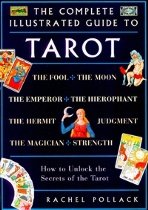|
Tarot Reflections |
February 15, 2003 |
|
Book Review:
Complete Illustrated Guide to Tarot Christopher delaMaison, CPTR |
||||
|
Rachel Pollackís book, Complete Illustrated Guide to TAROT, gives a refreshing look at introductory level tarot. The text is easy to read, well illustrated and covers a wide variety of materials related to the tarot, including Astrology and the Qabalah. The book is divided into six sections, an Introduction and five chapters, spanning 192 pages. The Introduction covers basic questions about Divination, the Tarotís structure, the Opening of the Minor Arcana, and the Modern Tarot. This introduction provides a very important basis for further study in the Tarot, as it outlines the efforts by A.E. Waite and Pamela Coleman Smith in creating the Minor Arcana images. An item of tarot history many readers take for granted. A writing device Rachel Pollack employs in her book is the idea of keeping a particular subject limited to two pages at most; and having those two pages opposite each other. This allows the reader to brief through the topic without having to turn a page. This method of laying out the various topics makes it easy to use this text for a beginning tarot course, as the student can see the topic at a glance without being distracted by having to search through a handful of pages during a lecture. It also limits the amount of information a student is exposed to at one particular time, allowing an instructor to touch on a topic, present material at an introductory level, and then move on. The first four chapters cover information that one may find in any other well-written tarot book: the Origins and History of the Tarot, Symbols and Structures within the Tarot deck, Interpretations of the Cards, and a variety of Reading spreads and techniques. Pollack does an excellent job in describing new ways to categorize elements of the Tarot, such as the Tarot Garden and Tarot Bestiary. She also repeatedly references both Astrology and the Qabalah throughout the book. This helps beginning readers to see the linkages between these three systems, as well as setting the foundation for possible additional esoteric studies at some future date. Such new perspectives gives the reader a fresh look at a subject that has been repeatedly dissected, compartmentalized, and, to some extent, trivialized. The fifth chapter, Things To Do With Tarots, covers different methods of getting to know your tarot cards. These include the well-known topics such as finding oneís personality, soul and year cards, meditation, and creating a personalized tarot deck. One of the more interesting methods is the use of tarot card games. Pollack lists a couple of card games she learned from another tarot author, Mary Greer: Tarot Rummy and Tarot Go Fish. Such games provide a framework to explore more creative outlets for tarot use, putting aside the seriousness often associated with working with a tarot deck. |
|||
|
Complete Illustrated Guide to Tarot is published by Element Books 1999/HarperCollins Publishers 2001, London, England. ISBN 0-00-713115-1. |
||||
|
Subscribe to Tarot Reflections, and receive notification of each update! |
|
Request to be added to the list by sending email to TarotReflections-subscribe@yahoogroups.com! |
All articles remain the
property of their respective authors.
Tarot Reflections is a publication of the American Tarot Association
- Copyright (C) 2003
Questions or Comments? Contact Us.

